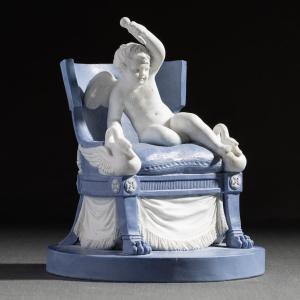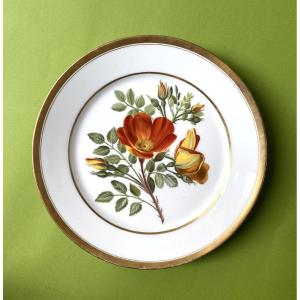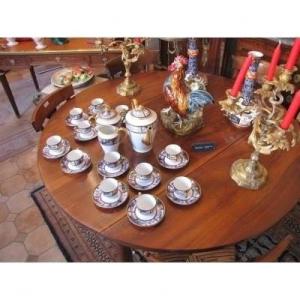Visible in Paris. Free worldwide shipping with DHL.
Cup and saucer
Hard paste porcelain enhanced with gilding
Red iron mark on the label
Dimensions: Saucer diameter 13.5 cm; Cup height 11 cm
Paris, circa 1820
Unusual ovoid cup and saucer with “thick gold” decoration throughout. Delicate contrasts between matte and burnished finishes. Relief decoration of pearl friezes, ovals, and palmettes applied using the “à la molette” process developed and patented by the Manufacture de Nast.
For a cup of this model, but with neo-Gothic painted decoration, see our sold items.
For a similar cup by the Deroche factory, see the Louvre collections, inv. no. 11008.
Darte Frères
Originally three brothers, they began manufacturing and trading porcelain in 1795 and bought a factory on Rue de Charonne, alongside which they opened a shop in the Palais Royal. In 1804, they parted ways amicably. Louis Joseph and Jean François founded a new company, keeping the name Darte Frères, and moved to Rue de la Roquette, while Joseph Darte continued under the name “Darte Ainé à Paris” and moved to Rue de Popincourt. The brothers prospered (employing 80 to 100 workers in peacetime) and an advertisement from 1809 announced that the factory bore the title “Manufacture de porcelaine de S.A.I. Madame Mère de S.M. L'Empereur et Roi” (Porcelain Manufacturer to Her Imperial Highness, Mother of His Majesty the Emperor and King). In 1816, a second store opened at 16 Rue Vienne (the first one at the Palais Royal had been in business since 1798). The factory participated in the 1819 exhibition and, as in 1806, won a silver medal. However, things became complicated in 1820, and three years later, the brothers divided up the assets of the struggling company. In 1824, Louis Joseph went into partnership with one of his sons, Auguste Remi, but the business declined a year later. In 1828, bankruptcy was declared.
Condition report: minimal signs of wear and tear
















































 Le Magazine de PROANTIC
Le Magazine de PROANTIC TRÉSORS Magazine
TRÉSORS Magazine Rivista Artiquariato
Rivista Artiquariato